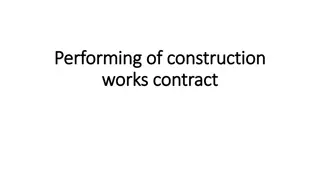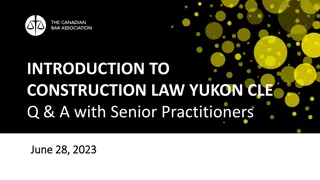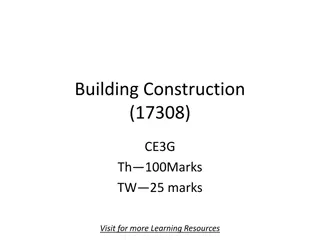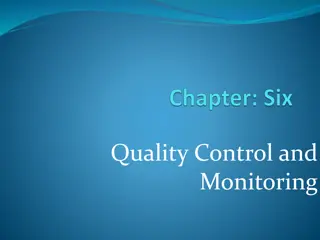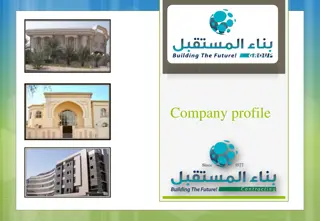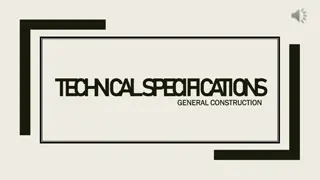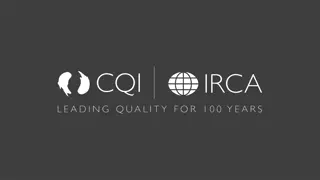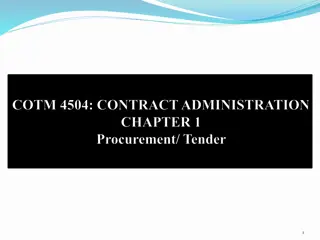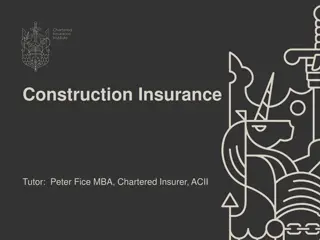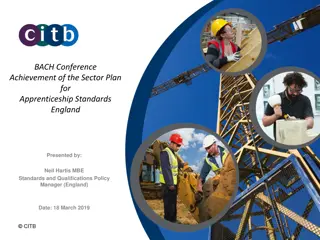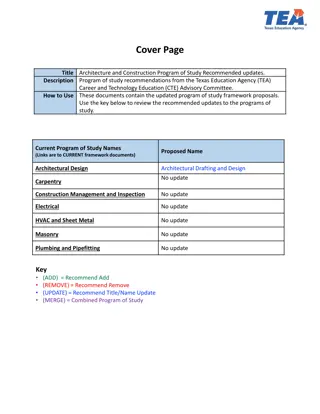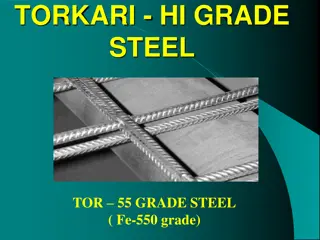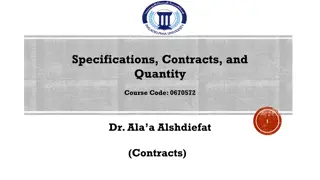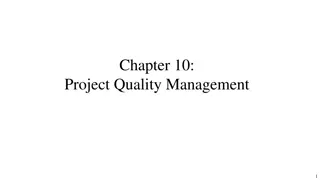Quality Program and Process in Manufactured Construction
The module explores quality management in manufactured construction, covering concepts, history, standards, control programs, defects, and more. Emphasizing the importance of quality in the construction process, it discusses the evolution of quality in manufacturing and its application in the manufactured construction sector. The content highlights the time-saving benefits and the impact of quality on financial conditions and reputation. Quality management principles such as planning, control, assurance, and improvement are essential components to ensure consistent quality in both processes and products.
- Quality Management
- Manufactured Construction
- Quality Control
- Quality Assurance
- Construction Standards
Download Presentation

Please find below an Image/Link to download the presentation.
The content on the website is provided AS IS for your information and personal use only. It may not be sold, licensed, or shared on other websites without obtaining consent from the author. Download presentation by click this link. If you encounter any issues during the download, it is possible that the publisher has removed the file from their server.
E N D
Presentation Transcript
BASICS OF MANUFACTURED CONSTRUCTION PRESENTED BY TRAMCON, UNIVERSITY OF FLORIDA MODULE 2: The Quality Program and Process for Manufactured Construction
Contents Module 2 The Quality Program and Process for Manufactured Construction 2.1 Introduction 2.2 Concepts and Definitions 2.3 History 2.4 Quality Standards 2.5 Quality Control Program for Manufactured Construction 2.6 Quality Control Process for Manufactured Construction 2.7 Defects and Possible Product Recalls 2.8 Accuracy and Precision in Manufactured Construction 2.9 Guidelines for Investigation and Reporting of Quality System Issues (QSI) MODULE 2: The Quality Program and Process for Manufactured Construction
Introduction This module includes: Explaining the various concepts and definitions used in the quality process in manufacturing. Discussing the history of quality in manufacturing and how it has evolved to the present day. Discussing the various types of standards and processes used in quality control management. Addressing how these concepts are applied in the manufactured construction sector, specifically to manufactured and modular homes. MODULE 2.1 Introduction
Introduction Quality in manufactured construction is built on a program that assures quality, checks it, and builds it into the management systems. MODULE 2.1 Introduction
Introduction The time savings resulting in manufactured compared to site built construction is in part a result of the quality built into the process. MODULE 2.1 Introduction
Quality The international standard, ISO 8402-1986, defines quality as ...the total of features and characteristics of a product required for its ability to satisfy stated or implied needs. Failure to meet quality requirements will have impacts on both the financial condition and reputation of a company. In the recent airbag recall involving the Takata Corporation, 34 million vehicles in the U.S. and 7 million more worldwide were potentially affected by defective airbags. MODULE 2.2 Concepts and definitions
Quality management Quality management has four main components: quality planning, quality control, quality assurance, and quality improvement. Quality management is focused both on the product being manufactured and the process by which it is manufactured. Quality management employs quality assurance and control of both processes and products to achieve consistent quality. MODULE 2.2 Concepts and definitions
Quality Management System (QMS) A quality management system (QMS) is a collection of processes needed to implement quality management. Elements of a QMS: 1. Quality policy 2. Quality objectives 3. Quality manual 4. Organizational structure and responsibilities 5. Data management 6. Processes, including purchasing 7. Product quality leading to customer satisfaction 8. Continuous improvement including corrective and preventive action 9. Quality instruments MODULE 2.2 Concepts and definitions
Quality Assurance Quality assurance (QA) is the systematic measurement, comparison with a standard, monitoring of processes, and an associated feedback loop designed to prevent errors. QA has two main principles: 1. Fit for the purpose 2. Right first time. The product should be designed to be suitable for its end use. The mistakes should be limited MODULE 2.2 Concepts and definitions
Quality control Quality control (QC) is a process of reviewing all the factors involved in the production process, with a focus on meeting quality requirements. Quality control emphasizes three aspects: Quality Assurance happens before the product is manufactured. Quality Control occurs during the manufacturing process. MODULE 2.2 Concepts and definitions
Quality control Quality control emphasizes three aspects: 1. Process elements controls, job management, defined and well managed processes, performance criteria, and records. 2. Competence knowledge, skills, experience, and qualifications 3. Non-process elements personnel, integrity, organizational culture, motivation, team spirit, and quality relationships. MODULE 2.2 Concepts and definitions
The origins of quality and quality control In Denmark, around 3500 BC, tools used in the production of Viking boats had been rejected at the time of building the boats. According to the Code of Hammurabi, the builder whose house later collapsed and killed the owner was subject to the death penalty. In ancient Greece construction work was subject to quality control and tools to control the quality of joints in construction were being utilized. The hallmark symbol, one of the first symbols of a quality control process indicated a product was created by a master craftsman. MODULE 2.3 History
The origins of quality and quality control The first measurement of length occurred in Egypt in about 3000 BC and was called the Royal Egyptian Cubit. Standard measures and special tools were used to build the Great Pyramids of Egypt in 2000-3000 BC. MODULE 2.3 History
Quality and the Industrial Revolution Frederick Taylor was one of the first to turn the management of quality and quality control into a science (In the late 19th century). His approach was threefold: 1. Find the best practice wherever it exists. 2. Disassemble the best practice into its constituent activities 3. Remove the activities that did not add value MODULE 2.3 History
Quality and the Industrial Revolution At the end of the 19th century the first groups were organized to produce standards for goods and their production. The American Society of mechanical engineers (ASME) - 1988 The American Institute of Electrical Engineers (AIEE) The American Society of Civil Engineers (ASCE) The American Society for Testing Materials (ASTM) MODULE 2.3 History
The Role of Japan Joseph M. Juran and W. Edwards Deming, concentrated on improving all organizational processes by the people who use them. By the 1970s, the US automobile industry and its supporting manufacturers were being badly outdone by Japanese manufacturers. Chrysler Corporation adopted the quality control systems developed by the Japanese and the company redesigned its entire product line. The result was that Chrysler products improved enormously and it became a profitable company once again. General Motors and Ford, underwent similar transformations MODULE 2.3 History
Quality Standards The best known and most frequently used standards for guiding and controlling quality are the International Standards Organization (ISO) 9000 family of standards. ISO 9000:2005 - covers the basic concepts and language ISO 9001:2008 - sets out the requirements of a quality management system ISO 9004:2009 - focuses on how to make a quality management system more efficient and effective ISO 19011:2011 - sets out guidance on internal and external audits of quality management systems. MODULE 2.4 Quality Standards
ISO 9000 - 8 principles A Customer Focus Good Leadership Involvement of people Process approach to quality management Management system approach Continual Improvement Factual approach to decision making Supplier relationships MODULE 2.4 Quality Standards
Quality Control program for Manufactured Construction HUD homes are subject to a very specific Federal regulation process. Modular homes are subject to the state building code in which the home will be installed. There is also an additional level of inspection audited by the state or third party, depending on whether is a modular home or a HUD home. As part of the production process, once production of the unit beings, a Traveler is produced. The Traveler is a document that outlines the quality control inspections that must be accomplished at each of the stations in the manufacturing process. MODULE 2.5 Quality Control Program for Manufactured Construction
Quality Control program for Manufactured Construction After all the required steps in the quality assurance and production process are completed at a station, a unit closeout occurs and the unit is moved to the next station in the production process. In a factory, a Quality Control Manager is responsible for checking compliance with quality control procedures. The party who is responsible for quality is the supervisor of the employees performing the tasks at a given station. MODULE 2.5 Quality Control Program for Manufactured Construction
Quality Control program for Manufactured Construction Manufactured HUD homes are identified by a HUD code label that is affixed to the outside of the home. MODULE 2.5 Quality Control Program for Manufactured Construction
IPIAs and DAPIAs There are 15 HUD approved state and private third party agencies that inspect a manufactured home at various stages of production. They are referred to as Inspection Primary Inspection Agencies (IPIAs). An additional type of third party agencies also approves the manufacturer's designs to ensure the plans are consistent with HUD Standards. This party is referred to as the Design Approval Primary Inspection Agencies (DAPIAs). MODULE 2.5 Quality Control Program for Manufactured Construction
On-site inspection When the factory built home is assembled and installed on- site, inspections are performed by the building department of the local municipality. Any deviations found by the building department inspectors are flagged and must be corrected by the team installing the home on its foundation. MODULE 2.5 Quality Control Program for Manufactured Construction
Quality Control Quality control is a process of ensuring compliance with the plans, specifications and the applicable building codes. The goal is for the problems to be resolved so that they can be avoided in the future. This is referred to as the Quality Assurance Procedure. There is normally contained in a Quality Assurance Manual that contains the information on a standard procedure. MODULE 2.6 Quality Control Process in Manufactured Construction
Plant Policy The purpose of the Plant Policy is to establish points of inspection, inspection procedures, and responsibilities for inspection and corrective action, defect control, and record keeping. MODULE 2.6 Quality Control Process in Manufactured Construction
Procedures for a Receiving Inspection Receiving Inspection is the process of inspecting all shipments of raw materials and components used in the manufacturing process. Rejection of any products or materials will be marked on the Bill of Lading and a copy maintained in the invoice file. MODULE 2.6 Quality Control Process in Manufactured Construction
General Inspections The purpose of an assembly system is to assure that the proper components, produced per the latest approved engineering drawings and specifications, are properly installed in their correct positions as detailed and identified on the drawings. Responsibility for the performance of the critical inspections is delegated by the Quality Control Manager to qualified persons of accountability. MODULE 2.6 Quality Control Process in Manufactured Construction
Inspection Checklists The Traveler checklist indicates the items to be inspected at each inspection point. All reports will identify each unit by its serial number and model and will include the date the unit entered the first stage of production. The Quality Manager is in-charge of the inspection forms at all times. MODULE 2.6 Quality Control Process in Manufactured Construction
Inspection Procedures A designated quality control representative Inspect the items listed in the QC checklist Any defects found will be noted Scheduling corrective action Sign the QC checklist off as corrected Final Inspection is performed by the Quality Manager or his representative prior to affixing a label on the unit, and the QC Checklists are then signed and filed. MODULE 2.6 Quality Control Process in Manufactured Construction
Defect Control The deviation will be noted on the Traveler by designated QC personnel and the corrective action will be scheduled and noted. The Quality Control Manager is responsible for evaluating the defects to determine if it is a random occurrence, or if it is related to a trend in defective material or workmanship. MODULE 2.6 Quality Control Process in Manufactured Construction
Quality Control Defect Control When defects are discovered by Quality Control Personnel, they note them on the QC Checklist, and notify the proper Production Personnel for scheduling corrective action. The Quality Manager will be responsible to make sure that any non-compliance is successfully corrected prior to affixing a Decal/Insignia on any unit manufactured by this plant. MODULE 2.6 Quality Control Process in Manufactured Construction
Layers of Inspection The local municipality inspectors Federal inspectors (For HUD homes) Third Party state inspectors In-house quality control department In-house station supervisor In-house station personnel MODULE 2.6 Quality Control Process in Manufactured Construction
Design Review Most states have a design approval and inspection system for modular housing similar to that used for manufactured housing. Includes requirements for quality control procedures and manuals, design review of all units produced, and in-plant inspections by state approved third-party agencies and/or the state itself. MODULE 2.6 Quality Control Process in Manufactured Construction
Defects and Possible Product Recalls Problems that are identified in the production process fall into one of four categories: Noncompliance Defect Imminent safety hazard Serious defect MODULE 2.7 Defects and Possible Product Recalls
Accuracy and precision The plans provide the exact dimensions required for each component that will make up a completed home. In general, a tolerance of 1/8 is normal for manufactured construction, that is, placing and cutting of components must be within 1/8 of the specified size or location. One attribute of deviations is that they are additive. MODULE 2.8 Accuracy and precision in manufactured construction
Guidelines for Investigation and Reporting of QSIs An important set of guidelines for assuring the quality of HUD homes is the Guidelines for Investigation and Reporting of Quality System Issues (QSI)issued by the Institute for Building Technology and Safety. HUD requires manufacturers to have a Quality System (QS) that is approved by the DAPIA agency and accepted by the IPIA agency. MODULE 2.9 Guidelines for Investigation and Reporting of Quality System Issues
Quality Assurance Manuals and IPIA Roles Federal Manufactured Home Procedural and Enforcement Regulations require that a manufacturer submits information about its Quality Assurance Manual so that the DAPIA agency in order can review and approve the manufacturer s Quality Assurance Manual. The manufacturer s DAPIA-Approved Quality Assurance manual outlines the programs, methods, procedures, personal responsibilities, training, checklists, forms, test equipment, documentation methods be used to assure compliance with the processes call for the manufactures Faulty Assurance Manual and the conformance of houses built. MODULE 2.9 Guidelines for Investigation and Reporting of Quality System Issues
Quality Assurance Manuals and IPIA Roles As a minimum the manual will include: 1. The manufacturer s quality assurance program 2. An organizational chart showing accountability, by position, of the manufacturer's quality control personnel 3. A description of production line tests and test equipment for compliance with the Standards 4. A station by station description of the manufacturing process 5. A list of quality control inspections required by the manufacture of each station 6. Identification by title of each person will be held accountable for each quality control inspection MODULE 2.9 Guidelines for Investigation and Reporting of Quality System Issues
The Role of the IBTS The Institute for Building Technology and Safety (IBTS) produces Guidelines for Investigation and Reporting of Quality System Issues (QSI). The IBTS Audit teams evaluate the performance of the IPIA agency and how well it is ensuring the manufacturer s compliance with the Quality Assurance Manual and the conformance of the homes being built. MODULE 2.9 Guidelines for Investigation and Reporting of Quality System Issues
The Role of the IBTS Quality Control Elements: Use of approved checklists Thoroughness of inspections Quality Assurance accountability Production line testing Work process and description correspond to the Quality Assurance Manual Compatibility of the work process and approved checklist Quality Assurance Operations Training Current Design approvals Designs used by plant personnel Availability of all applicable designs Receipt and storage of materials Installation of materials MODULE 2.9 Guidelines for Investigation and Reporting of Quality System Issues






